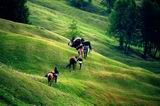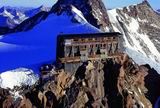| |||||
 |
Bognanco, Antrona and Anzasca valleys | ||||
| The first one is famous for its waters, the second is the wildest between the ossolane valleys, the third one is characterized by estern wall of Mount Rosa. | |||||
| Related images (1) |
|
BOGNANCO VALLEY The Bognanco valley is placed immediately behind Domodossola and offers the visitors an uncontaminated environment spotted with about ten little lakes. It is just the water to give peculiarity to the valley and to its most important centre: Bognanco, a name which includes a series of villages standing out from green fields and kitchen-gardens. In 1863 Father Fedele Tichelli discovered the therapeutic properties of the waters gushing out from the springs at the bottom of the valley. At the beginning of the twentieth century, after the discovery of the two new springs of Ausonia and Gaudenziana and then of St. Lorenzo, But all Bognanco valley is an open-air museum: ancient walls, sun dials, cheese factories, old presses, votive chapels are the evidence of the ancient rural culture.
ANTRONA VALLEY It is the wildest valley of the Ossola ones: thanks to its isolated position, it has kept an uncontaminated typical alpine environment. The principal peculiarity of this territory, created by a glacial erosion, is represented by the several natural and artificial little lakes; they are easily reachable on foot, and even fishing is practicable. Beside the clear stretches of water there are other attractions in these valleys: there are many possibilities of excursions through a net of 24 recommended paths, which lead to shelters and bivoucas: the climb to Pizzo d'Andolla, 3656 metres high, is particularly attracting for mountain climbers. Goiung up the valley the first reachable Commune is Montescheno, an inhabited centre formed by 12 fractions, with the typical architecture made of stone houses. The ancient wine-presses in the several fractions are witnesses of the past; one of these, which dates back to 1745 and has recently been restructured, is still partially utilized. The procession of “Autani”, the most ancient one in the Alps is full of charm and rituality; every year it starts from the village and runs along the paths of the mountains all day (22 km), and every family of the village takes part. A few kilometres from Montescheno there is Seppiana, which has been the religious centre of the valley since the XII century: the parish church of S. Ambrogio, dating back to the XI century and enlarged in the XII-XIII centuries, is a meaningful example of the alpine Romanesque style. Viganella was in the past the iron-working centre, from the middle Age till 1859, in Ogaggia the nowadays abandoned mines are reachable through a path which starts from the centre of the village. Antrona Schieranco is the Commune which occupies the head of the valley and is constituted by several villages as Triviera, an ancient mine centre, and Antronopiana with the parish church of S. Lorenzo, dating back to the XVII century, keeps a wonderful ciborium nowadays considered one of the best Baroque works of art of Piedmont. Antropiana is the greatest turistic centre in the valley and the starting point for summer excursions and winter ski touring. One of the most popular tourist destinations is Antrona Lake, created in 1642 by a landslide, which caused the obstruction of Troncone river.
THE ANZASCA VALLEY The landscape is dominated by the impressive outline of the eastern wall of Mount Rosa, the highest and the widest mountain of the Alps, often called “corner of Himalaya”. The peculiarity of this territory is the presence of two dominant cultures: the romance one in the low part of the valley, and the german-walser one in the northern one. At the beginning of the valley there is the village of Piedimulera, where you find the interesting seventeenth-century Testone palace and two towers of the XVI century; going on you reach the widest Commune of the valley, Calasca Castiglione, formed by several village placed on the mountain: Castiglione with its St. Gottard0's parish church, where it is possible to admire a valuable Gothic altar; Molini, where, every year on the occasion of the Assumption Day, the Traditional Army, in its Napoleonic costumes, parades near the Sanctuary of Gurva (XVII century); Antrogna, whose seventeenth century parish church, is named, for its setting, “the cathedral in the woods”. Bannio Anzino, formed by the villages of Bannio, Anzino and Pontegrande, was the ancient capital of the valley. St. Bartolomeo's parish church, a national monument dating back to 1644, which keeps a Flemish bronze Crucifix of the XVI century, is noteworthy. The seventeenth century Oratory of Madonna della Neve is every year the scene of a ceremony in which the Traditional Army takes place in memory of the Madonna's protection against a plague epidemic in the seventeenth century. Vanzone and San Carlo are the ideal starting points for excursions in the green: recommended paths to summer alpine pastures and peaks as Pizzo St Martino, which takes six hours on foot to be reached. Trekking lovers will surely appreciate the several excursions offered by the smallest Commune in the valley Ceppo Morelli; as the Tignaga valley, the Mondelli pass and Cortenero Alp. Macugnaga is the centre of the most marked tourist vocation, thanks to the wonderful view of the impressive eastern wall of Mount Rosa, a paradise for mountain climbers since the second half of the nineteenth century. The village was founded in the XIII century by the Walser settlers coming from the Saas valley, it has its most peculiar nucleus in the Dorf, a group of larch alpine huts and sheds, the ones in front of the others. The Old Church dedicated to the Virgin Mary is of great interest and dates back to the second half of the fourteenth century, with a church tower built in 1580. Near the Church there is a secular lime, with a girth, at the base of 7 metres wide, which is considered one of the most ancient in Europe. The visit to the Walser Museum in stirrup place is very interesting: a wood house of the XVII century with a stone base reproduces the typical aspect of a Walser house. Other interesting visits are to the Mountain Museum that documents the alpine history of the eastern wall of Mount Rosa, and the to fauna Oasis, which, through a close net of paths makes the contact with alpine flora and fauna possible.
Texts and images are published with courtesy of Lake Tourist District Scrl - corso Italia 18 Stresa (VB)
| |
 |
Search other Guides |
Related arguments
| Antigorio and Formazza Valleys |
| Bognanco, Antrona and Anzasca valleys |
| Borromeo Gulf |
| Divedro Valley |
| Lower Verbano |
| Mergozzo Lake |
| Orta and its lake |
| Ossola Plain |
| The area of Vergante and Mottarone mount |
| Upper Verbano |
| Valgrande Valley |
| Verbania and its environs |
| Vigezzo Valley |

 In the garden
In the gardenThe initiative, which is scheduled to run from June 26th to September 13th, 2020, is inaugurating a temporary space for art in Corso Matteotti 5, in Milan, in the very heart of the city.
 Modigliani and the Montparnasse Adventure
Modigliani and the Montparnasse AdventureOn 22 January 1920 Amedeo Modigliani was taken, unconscious, to the Hôpital de la Charité in Paris and died there two days later at the age of only 36, struck down by the then incurable disease of tubercular meningitis that he had miraculously managed to survive twenty years earlier.
 Madonna di Campiglio - Pinzolo - Val Rendena Travel Guide
Madonna di Campiglio - Pinzolo - Val Rendena Travel GuideThe Brenta Group of the Dolomites and the perennial glaciers distended on the granite peaks of the Adamello and Presanella encase the Rendena Valley, running up to the crowning charm of Madonna di Campiglio.




 Bognanco became one of the most famous Italian thermal resorts, getting rich in establishments, hotels and lodging structures. Walks and relax represent a pleasant addition to the thermal cures: for art and culture estimators visiting the sixteenth-century parish church of St Lorenzo, placed in the homonymous hamlet, the oratory of Pizzanco, dedicated to St Uguccione the dairymen and shepherds' patron, St Bernardo's oratory (XVII century), the mountaineers and mountain climbers' patron, placed in a wonderful position at the height of 1620 metres, is interesting. For trekking lovers there are several possible choices of destinations, among the most popular ones there are: Ragozza lake, Paione and Variola little lakes and the Monscera pass. Going up from Bognanco Fonti to St Lorenzo, you reach the village of Camisanca which has perhaps the most beautiful building of the valley, the powder-magazine, and a sixteenth-century Fort-House dating back, on its facade, to 1578.
Bognanco became one of the most famous Italian thermal resorts, getting rich in establishments, hotels and lodging structures. Walks and relax represent a pleasant addition to the thermal cures: for art and culture estimators visiting the sixteenth-century parish church of St Lorenzo, placed in the homonymous hamlet, the oratory of Pizzanco, dedicated to St Uguccione the dairymen and shepherds' patron, St Bernardo's oratory (XVII century), the mountaineers and mountain climbers' patron, placed in a wonderful position at the height of 1620 metres, is interesting. For trekking lovers there are several possible choices of destinations, among the most popular ones there are: Ragozza lake, Paione and Variola little lakes and the Monscera pass. Going up from Bognanco Fonti to St Lorenzo, you reach the village of Camisanca which has perhaps the most beautiful building of the valley, the powder-magazine, and a sixteenth-century Fort-House dating back, on its facade, to 1578.